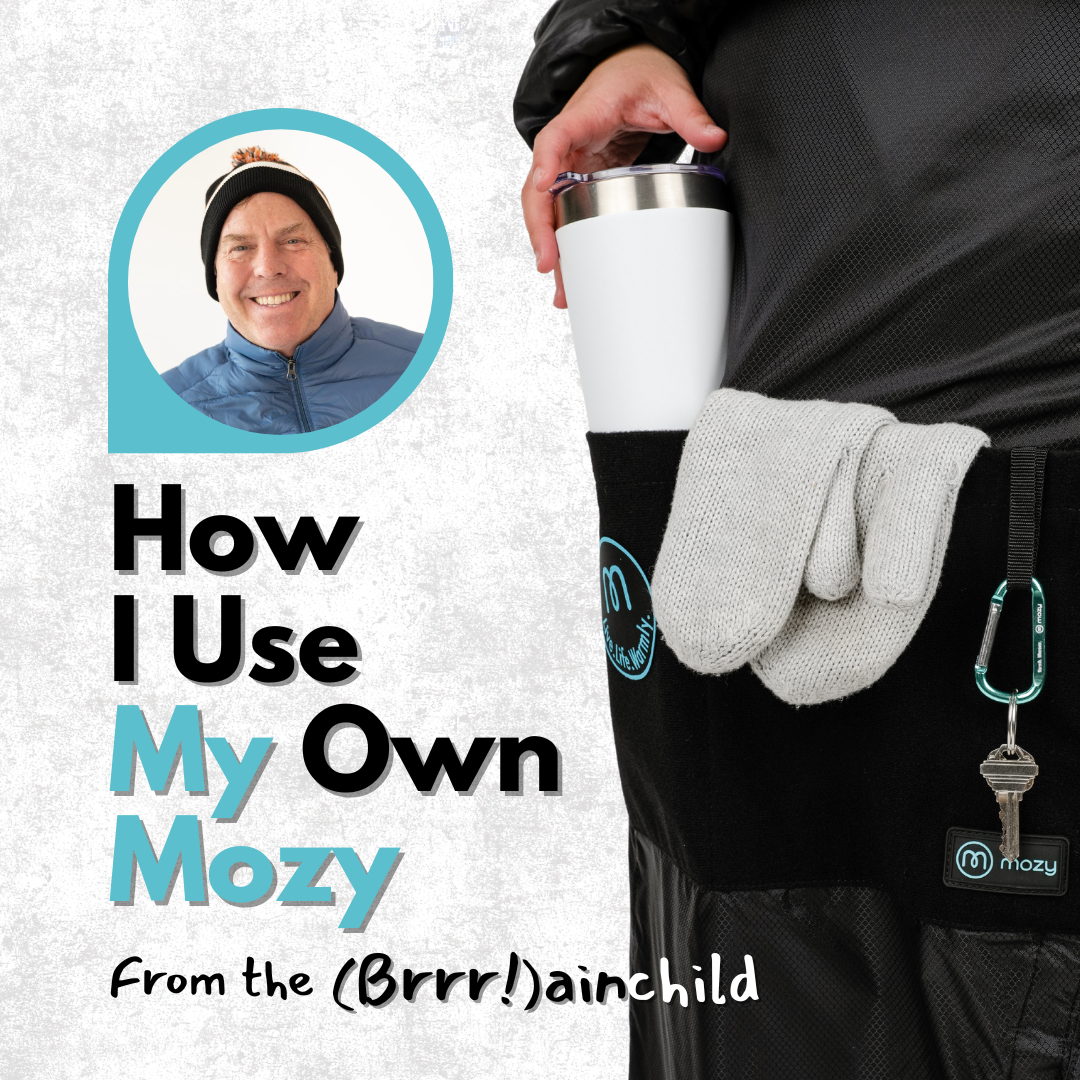Science Says: Our Personal Thermostats
Explain Why Some People
Run Colder (or Hotter) Than Others
Author: The Mozy Content Team is made up of outdoor-loving storytellers dedicated to helping you stay warm, cozy, and connected—wherever life takes you. We share tips, stories, and updates inspired by real Mozy moments and our amazing community.
If you’ve ever had a tug-of-war with a loved one over the thermostat, then you know that person’s “cozy comfy” is another person’s “I’m freezing!” And while it may feel like personal preference, there’s a lot of science behind why some of us always run cold, while others seem perpetually warm.
Basically, our bodies come with built-in thermostats that give each of us a unique take on “comfort” based on our biology, psychology, and natural surroundings.
Scientists who study thermoregulation are constantly uncovering new information about why you might shiver in a hoodie while your friend is comfortable in shorts (and why some of us really need Mozy). Let’s take a closer look:

The Body’s Thermostat: Always On Duty
At the center of this story is the hypothalamus. That’s just a big word for a small region in your brain whose job is to keep your core temp steady. This is the “healthy” 98.6°F baseline we all learned about as kids.
When you get too warm, the hypothalamus orders your body to cool off. When you get too hot, you sweat, and your skin starts to flush as warm blood moves closer to the surface to let heat escape. When you’re too cold, it tells your body to conserve and generate heat. This is why we experience things like shivering, goosebumps, or restricted blood flow to our hands and feet.
This balancing act is called thermoregulation, and it’s why humans can survive in deserts, mountains, and everything in between. (We aren’t lizards!) But while the system works the same for everyone, not all thermostats are alike.
Why Some People Run Colder
If you’re the one wrapping yourself in blankets while everyone else looks fine, science has a few explanations.
Body Size, Shape, and Fat Distribution
Science tells us that smaller, leaner bodies lose heat faster. The more surface area you have relative to your mass, the more heat escapes. Children, for example, feel cold more quickly than adults. Women often report feeling colder than men. This is partially due to size, but also differences in fat distribution and skin thickness mean the body can feel chilly, even though the core temperature is unchanged. Important note: this is usually a matter of comfort, not safety. Feeling cold at the skin level doesn’t mean your body is in danger. True risk only happens when core body temperature drops significantly.
Metabolism and Thyroid Function
Your metabolism is basically your internal furnace. A slower metabolism means less heat output. This is why hypothyroidism (an underactive thyroid) often leaves people sensitive to cold. Likewise, hyperthyroidism heats the furnace up, making you feel warm even in cool rooms.
Circulation
Circulation is another factor in why some people feel cold all the time. When your body senses cold, it tightens blood vessels in your extremities to conserve heat for vital organs. This is why your fingers and toes might always feel cold. Some people have stronger vasoconstriction responses, which can make them feel colder even when their core temperature is fine.
Nutrient Levels
Lastly, low iron (anemia) means your blood carries less oxygen, which fuels less heat production. That can leave you feeling colder than your non-anemic friends.

Why Others Run Hot
So, that’s why some people feel cold all the time. Then, there are the people who crack a window in January because they’re always hot. It’s unlikely they’re a werewolf, so what’s going on with them?
Higher Metabolic Rate
Muscle burns more energy than fat, and that energy gives off heat. So if you’ve got more muscle mass or a naturally faster metabolism, you might notice you “run hotter” than most. For example, someone who lifts weights a few times a week might feel cozy in a room that leaves their smaller, skinny friends reaching for a sweater.
Hormonal Shifts
Hormones play a surprisingly big role in how hot or cold we feel. For example, during the menstrual cycle, the key hormone progesterone nudges a woman’s core body temperature up by a fraction of a degree. It’s subtle, but it can make women feel warmer or more sensitive to temperature changes during the back half of their cycle.
Then there’s menopause, which does all kinds of things to women’s hormone levels. Many people experience “hot flashes.” Scientists believe this happens because the body’s “thermostat” becomes more sensitive. Basically, small changes that wouldn’t bother someone else suddenly trigger a woman’s body’s cooling or heating responses. That’s why Mozy is the perfect gift for someone going through “the mid-life fun phase.”
Circulatory Differences
Another reason some people run hot is how easily their blood vessels dilate. When vessels widen, warm blood flows closer to the skin, helping the body release heat. This is excellent when you’re exercising on a hot day because it means your body can efficiently cool itself. But in normal settings, it can make you feel warmer than those around you. AKA: you become the person sweating during an indoor business meeting.
Brown Fat: The Secret Space Heater
Not all fat is created equal. Brown adipose tissue (BAT or “brown fat”) is special: instead of storing energy, it burns calories to create heat. Babies have a lot of brown fat (which helps them stay warm), but adults keep small amounts in areas like the neck and shoulders.
Some research suggests people with more active brown fat are better at tolerating the cold. This could be adults who are lean, physically active, or exposed to cooler temperatures regularly. Even something as simple as spending time outdoors in cooler weather or doing mild cold exposure (like cold showers or winter workouts) can stimulate brown fat activity.

The Influence of Gender, Genetics, and Geography
There’s no universal “comfort zone.” A few key factors help explain why:
Gender differences: Studies show women tend to feel colder than men at the same room temperature. Reasons include lower muscle mass, hormone fluctuations, and circulation differences.
Genetics: Some people may have a slightly different hypothalamic “set point,” or more/less sensitive temperature receptors in the skin.
Environment and acclimatization: Grow up in a cold climate? Your body adapts by conserving heat more efficiently. Live in the tropics? You sweat faster and cool down more easily.
That’s why someone from Minnesota can shrug off a chilly day while a Florida native reaches for a parka.
When Temperature Sensitivity Signals Something More
Most of the time, running hot or cold is just part of your physiology. But sometimes it’s a clue your body is asking for help.
Always cold?
Always hot? Hyperthyroidism, certain medications, or menopause might be at play.
Check in with your doctor if your tolerance shifts suddenly or feels extreme.
How Your Personal Thermostat Shapes Everyday Life
This might help you know when and where to always have your Mozy.
At the Office
Workplace thermostat wars are so common that they’ve been studied. In fact, the standard “office temperature” was originally set in the 1960s, based on the metabolism of an average man. No wonder so many women report being uncomfortably cold at work!
At Night
Sleep depends on a drop in core body temperature. Hot sleepers may toss and turn unless the bedroom is cooler, while cold sleepers may need extra blankets to fall asleep.
At Home
Partners often disagree on what “comfortable” means. One wants the thermostat at 74°F, the other insists on 68°F. Neither is wrong — they just have different thermostats built in.
This is where Mozy can bridge the gap without starting a thermostat cold war.
Practical Ways to Hack Your Thermostat
You can’t rewrite your biology, but you can work with it:
• Layer up (or down). Flexible layers beat one heavy sweater every time.
• Keep extremities warm. Socks and slippers matter more than you think.
• Move around. Even light activity boosts circulation and warms you up.
• Sleep smart. Warm shower + cool bedroom = better sleep for hot sleepers.
• Acclimatize gradually. Regular exposure to cooler or warmer environments helps your body adjust.
• Check your health. If your hot/cold balance feels unusual, get your thyroid, iron, or circulation checked.
• Carry Mozy everywhere you go. Mozy is designed to travel and keep the lower half of your body warm in just about any setting.
The Bigger Picture
At the end of the day, your personal thermostat is unique. And since comfort is such a personal equation, it makes sense that carrying a Mozy everywhere keeps you best prepared for all scenarios.



